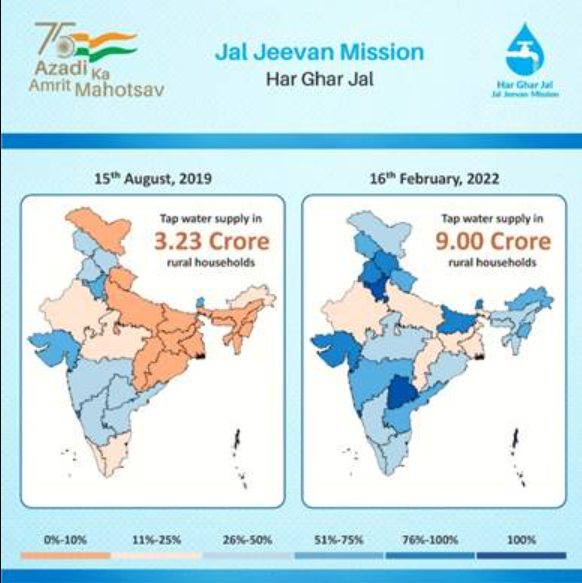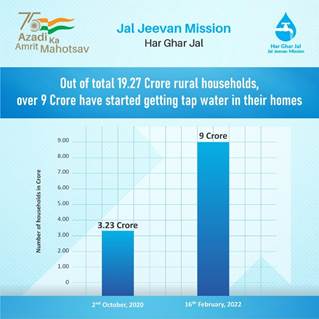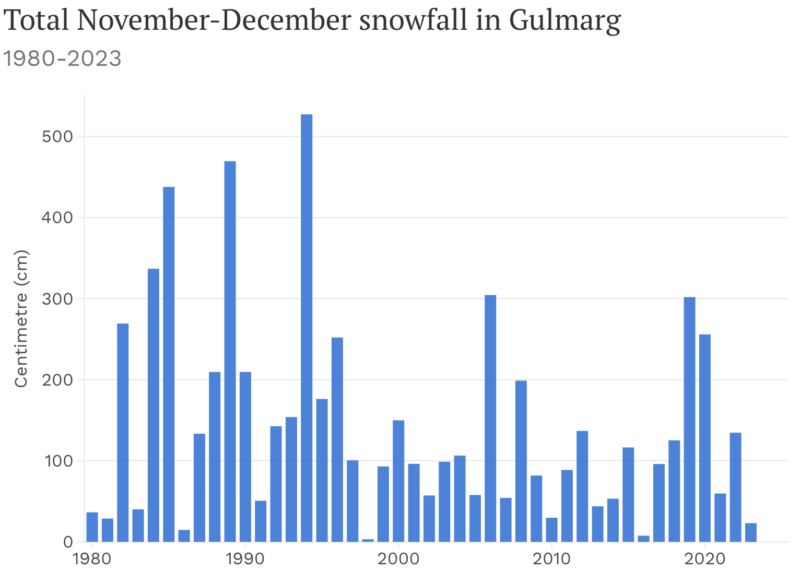CONTENTS
- Providing Clean Water to All
- Decline in Snowfall in the Himalayas
Providing Clean Water to All
Context:
In the mountainous village of Kyarkuli Bhatta in Uttarakhand, there is no longer a trend of mass migration. The tribal settlement of Kusumdih in Jharkhand has witnessed a decline in conflicts between humans and animals. Additionally, in Chandpur village, Maharashtra, elaborate wedding celebrations have resumed. This positive transformation is attributed to the availability of tap water in these regions, courtesy of the Jal Jeevan Mission.
Relevance:
GS-2
Government Policies & Interventions
- GS-3
- Skill Development
- Employment
Mains Question:
‘At the heart of the Jal Jeevan Mission lies a commitment to strengthen the socio-economic fabric of rural communities.’ Analysing the success and failures of the mission, examine how true has it been to the above statement. (15 Marks, 250 Words)
About the Jal Jeevan Mission:
Overview:
- Introduced in 2019, the Jal Jeevan Mission aims to provide 55 litres of water per person per day to every rural household by 2024 through the installation of Functional Household Tap Connections (FHTC).
- It seeks to instigate a “jan andolan” (people’s movement) for water, making it a collective priority. The mission falls under the purview of the Jal Shakti Ministry.
Objectives:
- The mission focuses on ensuring the functionality of existing water supply systems and connections, monitoring and testing water quality, and promoting sustainable agriculture.
- It also emphasizes the conjunctive use of conserved water, augmentation of drinking water sources, development of drinking water supply systems, greywater treatment, and its reuse.
Key Features:
- The Jal Jeevan Mission adopts an integrated approach to manage water at the local level, with a special emphasis on creating local infrastructure for source sustainability, including rainwater harvesting, groundwater recharge, and household wastewater management for reuse.
- Community participation is a fundamental aspect, and extensive Information, Education, and Communication efforts are integral to the mission.
Implementation:
- Village water supply systems are planned, implemented, managed, operated, and maintained by Paani Samitis, which are committees consisting of 10-15 members.
- These committees include at least 50% women members and representatives from Self-Help Groups, Accredited Social and Health Workers, Anganwadi teachers, among others.
- The committees prepare a one-time village action plan that consolidates all available village resources, and the plan is approved in a Gram Sabha before implementation.
Funding Structure:
- The funding distribution between the Central and state governments follows a pattern of 90:10 for Himalayan and North-Eastern States, 50:50 for other states, and 100% for Union Territories.
- The mission, guided by the principle of ‘Sabka Saath, Sabka Vikas, Sabka Vishwas aur Sabka Prayas’ (Collective Efforts for Inclusive Development with Trust), is propelling India rapidly towards achieving the United Nations’ Sustainable Development Goal 6, which focuses on ensuring clean water and sanitation for all.

- This venture was initiated with the goal of supplying piped water in sufficient volumes and meeting specified quality standards consistently and over the long term for every rural household in India.
- Its aim was to eradicate water scarcity and mitigate its impact on health, hygiene, and overall well-being.
- Nationally, the emphasis was on enhancing infrastructure, a formidable task due to the diverse terrains and geographical variations in India.
- Collaboration among communities, development partners, and NGOs was fostered to address this challenge collectively.
- Recognizing that a uniform solution may not be suitable for all circumstances, the diverse needs of different regions were acknowledged. However, guided by the overarching principle of ensuring that no one is left behind, the Jal Jeevan Mission addressed various challenges.
- In mountainous and cold areas, were employed insulated pipes, while villages grappling with water quality issues saw the implementation of multi-village schemes involving bulk water transfer.
- To address immediate drinking and cooking water needs, community water purification plants were installed.
Success of the Mission:
- Since its launch in 2019, the mission has successfully provided tap water to 73% of rural households.
- This milestone signifies that over 14 crore rural households now have tap connections, a significant increase from the 3.23 crore households in August 2019.
- Numerous research efforts have explored the Jal Jeevan Mission, its execution, and outcomes. According to a study by Nobel Laureate Dr. Michael Kremer, the provision of safe water has the potential to reduce infant mortality by nearly 30%, potentially preventing 25% of deaths among children under the age of five in India (equivalent to 1,36,000 child deaths annually).
- Another study conducted by the World Health Organization during the fiscal year 2023-24 suggests that providing tap water in every household could prevent 4 lakh diarrhoeal deaths.
- The Jal Jeevan Mission is anticipated to generate economic savings of up to $101 billion or ₹8.37 lakh crore.
- The Nal Jal Mitra initiative is a specialized program equipping villagers with a comprehensive skill set to conduct minor repairs and maintenance of the piped water supply scheme in their village.
- Under the Jal Jeevan Mission, over 5.29 lakh village water and sanitation committees/Pani Samitis have been formed, accompanied by the development of 5.17 lakh village action plans.
- Additionally, approximately 22.98 lakh women have received training to test water samples using field testing kits.
- According to a recent study titled ‘Assessment of Employment Potential of Jal Jeevan Mission,’ the mission has the potential to generate an average of 59.93 lakh person-years of direct employment and 2.22 crore person-years of indirect employment during the construction phase.
- Furthermore, it is estimated to provide an additional 11.18 lakh person-years of direct employment annually during the operation and maintenance stage.
- The Department of Drinking Water and Sanitation actively maintains a Water Quality Management Information System, facilitating the prompt detection of contamination or deterioration in water quality. This proactive approach allows for immediate corrective action and grievance redressal.
- Presently, there are 2,113 labs across India, and the water quality testing labs of States/Union Territories are now accessible to the public for testing water samples at nominal rates.
- In the fiscal year 2023-24, more than 46.62 lakh water samples have been tested in laboratories, and the results are digitized in the Water Quality Management Information System.


Challenges in the Jal Jeevan Mission:
- Impact of the COVID Pandemic: The progress of the scheme faced setbacks during the COVID pandemic, impacting the availability of essential materials like pipes and other construction resources, leading to delays in its implementation.
- Challenges Due to Inadequate Infrastructure: A significant challenge is the insufficient infrastructure for water supply in rural areas. Many villages lack essential pipelines, storage tanks, and treatment facilities.
- Issues with Water Quality: States like Kerala and Bengal encounter problems with water contamination, posing barriers to ensuring access to safe drinking water. Climate change, over-extraction, and water source contamination threaten the long-term viability of water sources.
- Geographical Diversity: India’s rural areas exhibit diversity in geography and terrain, making it challenging to implement uniform water supply solutions. For instance, Mahoba in UP relies on lakes and ponds for irrigation, but the rocky sub-surface limits perennial groundwater sources, leading to poor scheme implementation.
- Groundwater Depletion and Urbanization: Groundwater depletion is a significant challenge often overshadowed by the focus on surface water sources. Rapid urbanization increases water demand, leading to overexploitation of groundwater. Urban expansion covers soil surfaces with impermeable materials, reducing groundwater recharge.
- Interstate Water Disputes and Federalism: Conflicts over water-sharing agreements between states, such as the Cauvery River dispute between Karnataka and Tamil Nadu, underscore tensions between state autonomy and national interest.
- Water Quality and Health Concerns: Beyond quantity, water quality is a grave issue. Industrial discharge, agricultural runoff, and inadequate sanitation lead to waterborne diseases, impacting public health, especially in rural areas.
- Gender Dynamics and Water Collection: In many rural areas, women and girls shoulder the responsibility of fetching water, limiting their educational and economic opportunities and exposing them to harassment and violence during long walks to distant water sources.
- Climate Change and Glacial Retreat: Himalayan glaciers, crucial water sources for Indian rivers, are receding due to climate change, potentially causing water shortages in the long term and affecting millions relying on these rivers for irrigation and drinking water.
- Inefficient Wastewater Management: With water resources in short supply, inefficient wastewater management hampers India’s ability to economically utilize water. According to a recent report by the Central Pollution Control Board (March 2021), India’s water treatment capacity is 27.3%, and sewage treatment capacity is 18.6%.
Conclusion:
Through the Jal Jeevan Mission, significant milestones have been achieved. However, the future plan should encompass eradication of water scarcity entirely, ensuring that no rural household experiences a shortage of this essential life source. Active involvement of communities in the maintenance of the water assets that have been established is needed. Our trajectory should be aligned with the attainment of our drinking water targets, with the necessary resources in position to execute these objectives.
Decline in Snowfall in the Himalayas
Context:
Snowfall brings joy to residents of Himalayan states, contributing to the local economy through tourism. However, this year, several Himalayan regions that typically experience snowfall from December to January have witnessed a lack of snow. Popular tourist destinations like Shimla, Manali, and Gulmarg have seen a significant decline in snowfall, leading to a reduction in tourist visits and impacting the local economy. In January, temperatures in Shimla and Manali were warmer than those in the national capital region.
Relevance:
GS-1
- Important Geophysical Phenomena
- Physical Geography
- Water Resources
GS3-
- Conservation
- Environmental Pollution and Degradation
- Environmental Impact Assessment
Mains Question:
How does the decline in snowfall effect the Himalayan ecosystem? What are the possible reasons behind this decline and what can be done to effectively reduce its impact? (15 Marks, 250 Words).
More on the Snowfall:
Understanding the Occurrence of Snowfall:
- Snowfall occurs almost every time it rains, with snow often melting before reaching the Earth’s surface. It manifests as ice water precipitation in the form of virga or flakes descending from the sky.
- Typically associated with high, thin, and delicate cirrus clouds, snow can fall even when the air temperature is above freezing, although it is more common in below-freezing conditions.
- When the air temperature rises above freezing, snowflakes may undergo partial melting, but due to relatively warm temperatures, the particles evaporate rapidly.
- This evaporation cools the surrounding snowflake, causing it to descend to the Earth as snow.
- Characterized by its fluffy, white, and soft nature, snow comes in various shapes and forms, such as flat plates and tiny needles.
- It is essential to recognize that atmospheric conditions, such as temperature and humidity, play a pivotal role in determining whether precipitation manifests as rain or snow.
- Warmer temperatures generally favor rain, whereas colder temperatures lead to the formation of snow.
- Snow covers an area of nearly 46 square kilometers annually and plays a crucial role in the Earth’s climate system.
Role of Snowfall in the Climate System:
- Its presence influences both the Earth’s surface and atmosphere, impacting local weather patterns.
- Snow exhibits significantly higher reflectivity than trees, reflecting over 80% of incoming sunlight, while trees only reflect approximately 30%.
- Considering these factors, it is unsurprising that alterations in snowfall and snowpack can have significant repercussions both locally and globally.
- The impact on essential plants like apple trees, crucial for the region’s economy, is severe, as snow plays a vital role in their growth, acting as an insulator and contributing to soil moisture. The evolving environment poses a long-term risk to the delicate ecological balance.
Possible Reasons Behind this Occurrence:
- The primary factor anticipated to induce changes in precipitation and snowpack is global warming. Contrary to common assumptions, global warming doesn’t necessarily lead to a reduction in snow accumulation.
- The quantity of snowfall in a specific area is contingent on orographic conditions, particularly those found in the nearby mountains.
- Tourism and developmental activities in Himalayan hill stations such as Manali and Gulmarg have substantially transformed the landscape.
- The influx of vehicles, along with tunnel construction and hydroelectric projects, elevates local temperatures and contributes to pollution.
- Irresponsible tourist behavior, including littering in the snow, is compounded by similar actions from the local community, while government agencies remain passive observers. These trends pose a threat to the livelihoods of locals dependent on tourism and agriculture.

Way Forward:
- IMD scientists should address the local orographic factors influencing snowfall in our mountains.
- They should train local students knowledgeable about the region’s ecology and climatic conditions, incorporating them into their scientific endeavors.
- Students should undergo on-site training with scientists even during their coursework.
- The government should implement stringent regulatory measures to safeguard our snowfalling regions by designating them as ‘Snow Reserves,’ allowing for the regulation of tourism and developmental activities in these areas.
Conclusion:
While the India Meteorological Department (IMD) has not officially commented on the decrease in snowfall, casual observations suggest a disruption in climatic patterns. Scientists may offer theoretical explanations related to global climate changes, but there is a lack of precise scientific studies addressing local climatic issues. If corrective measures are not taken now, it will impact the lives of the entire Himalayan belt and beyond. Mother Nature has already issued a warning; it is up to us to take action.





